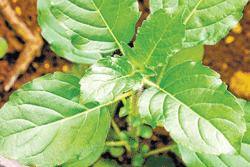Use the goodness of tulsi
One plant with multiple utility values is tulsi. Tulsi is found in almost all Indian households and even worshipped religiously by the Hindus.

The plant: It is a small plant and there are many varieties. However, Ram tulsi (with light green leaves) and Shyam tulsi (with black leaves) are the most common. Both have almost similar properties despite the difference in colour.
Different names: Tulsi is known by different names in different languages. For example, Gauri or Vrinda in Sanskrit, Shree tulsi in Kannada and holy basil in English are names of the same plant. It is also known as ocimum sanctum in Latin.
In Indian culture, this plant is said to be the abode of all the gods. The plant possesses a lot of antibiotic properties. And all it requires is a bit of water to help it flourish in your garden.
Uses
All parts of the plant — like leaves, flowers, roots and bark — can be used to our benefit. As the plant contains antibiotic properties in its different parts, it is generally used to cure contagious and infectious diseases. It is said that a Tulsi stand can clean even the polluted air around.
It is good for the heart and easily digestible. It corrects the deficiencies in the blood and is a great fixer of ailments such as vommitting, hiccups, epilepsy and fever. Taking a few leaves of tulsi daily is known to keep common ailments such as colds and coughs at bay. It also has a good effect on the overall health of the body and digestion of food.
Ten leaves of tulsi, ground with five black peppers and five almonds, and taken with a little honey can help improve memory.
Tulsi leaves are specific for many fevers. During rainy season, its leaves boiled with tea act as prevention against various types of fever.
You can also get rid of any nasty headache with the juice of tulsi. A few drops of its juice when applied on the nose or rubbed on the forehead also cures headaches. Swallowing two or three leaves of tulsi after a meal removes bad odour and is good for the teeth and gums.
Alkaloids found in tulsi are helpful in detoxification of the skin. Add a few leaves to a jug of water and drink it up. This will help clean up the stomach.
Mixing the leaves to coriander, mint and curry leaves chutney adds zing to your meal. Tulsi can also be added to soups and rasams as garnish.
The plant contains natural mercury, which may be harmful to teeth if the leaves are chewed. It is best to swallow the leaves whole with water.
Deccan Herald is on WhatsApp Channels| Join now for Breaking News & Editor's Picks